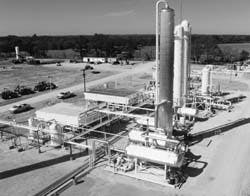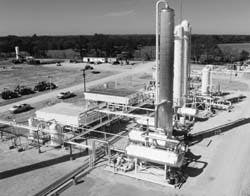TECHNOLOGY Giddings Austin chalk enters deep lean-gas phase
Guntis Moritis
Production Editor
Deep lean gas is the latest phase in the growth of the Giddings field Austin chalk play.
The first phase involved drilling vertical oil and gas wells. Next came the horizontal well boom in the shallower Austin chalk area, which is still continuing. And now this third phase places horizontal laterals in the Austin chalk at about 14,000-15,000 ft to produce lean gas.
Producing wells
Union Pacific Resources Co.s (UPR) first deep Austin chalk well was drilled last September.
Through last November, UPR had connected 13 wells to a new lean-gas gathering system, and 9 wells were producing about 110 MMcfd. UPR says the best well, drilled in April, had produced a cumulative of 4 bcf through November, and it and one other well continue to produce about 25-30 MMcf each.
As with other Austin chalk wells, deliverability depends on encountering fractures.
For 1996, UPRs plans include drilling an additional 18 wells in the deep chalk. It had four rigs running at the end of November. Eventually, it may drill as many as 56 wells over a 3-4 year period. About 8 weeks are needed to drill and complete an average well.
UPR says that three of the wells connected to the gathering system but not producing at the end of November may be recompleted.
A typical UPR deep Austin chalk gas well is on 1,000-acre spacing and includes open hole, 634-in., opposing horizontal laterals drilled below 758-in. casing. Each lateral is about 3,500-4,000 ft long.
These wells encounter high reservoir temperatures of about 350 F. that limit the tools and muds available for drilling. Mud circulating temperatures have reached 300 F.
The wells typically produce through 278-in. tubing.
UPR has considerable experience in drilling horizontal wells, having drilled over 1,100 horizontal wells since 1987 (OGJ, Dec. 11, p. 39). At the end of November it was operating 21 drilling rigs in the Austin chalk area.
Gas gathering
The Ferguson-Burleson County Gas Gathering System, 55% owned by UPRC and 45% by Mitchell Energy & Development Corp, collects gas in the Giddings field area. The gas is purchased by another UPR and Mitchell joint venture called Austin Chalk Natural Gas Marketing Services. The marketing services ownership percentage is the same as the gathering system. Both joint ventures are operated by Mitchell.
Union Pacific Fuels markets the majority of the gas from the lean gas system throughout Texas.
Since 1981, Mitchell and UPR have shared ownership in various gas gathering, processing, and treating facilities in Burleson, Robertson, Brazos, Grimes, Waller, and Washington counties. The joint-venture holdings include three gas processing plants near Bryan, Tex. (the Bryan, Bryan Hicks, and A&M plants) and 1,488 miles of pipeline (Fig. 1)(31322 bytes). In the older gathering system, the joint venture collects and processes about 220 MMcfd of rich natural gas (about 4-6 gal/MMcf) of which about 130 MMcfd is processed in the joint venture plants.
Liquid Energy Corp.s Madison plant processes about 30 MMcfd, and about another 60 MMscf is processed at Exxon Co.s Katy plant.
The new 44-mile, lean-gas gathering system accommodates the production from the deep Austin chalk wells (OGJ, Nov. 27, p. 35). The pressure in the system is about 1,000-1,150 psi. Well head pressures range from 1,500 to 3,000 psi.
Carbon dioxide and some hydrogen sulfide are removed at the new Anderson gas treating plant before gas enters one of three pipelines. The Anderson plant became fully operational on Aug. 28.
Pipeline connections have been made at the tailgate of the treating plant to Lone Star Pipeline Co., Tejas Gas Pipeline Co., and Aquila Southwest Pipeline Corp.
The joint venture laid the 9-mile, 16-in. pipeline to Tejas pipeline that has the capability of handling up to 180 MMcfd. The connection with Lone Star provides for transportation of up to 200 MMcfd, and the Aquila connection has a capacity to take 100 MMcfd. Mitchell says these pipeline connections will provide access to markets at Katy and Carthage, Tex., as well as many other intrastate and interstate pipeline markets.
The Anderson plant is designed to reduce the lean gas CO2 content from about 612% to the pipeline specification of 3%. A specialty amine containing MDEA is used in the absorption process. Mitchell says the proprietary formulation allows for slip so that only the CO2 above the 3% pipeline specification is absorbed.
The Anderson plant is rated for 800 gpm amine circulation and can process up to 180 MMcfd. In November, the amine circulation rate was about 700 gpm.
Reconditioned vessels were used to build the Anderson plant. Mitchell says that the reconditioned vessels saved costs and allowed the plant to be on stream several months earlier. Delivery time for new vessels would run between 9 and 12 months, according to Mitchell.
Mitchell says cost of the reconditioned plant was about $2.2 million or about $6-6.5 million with installation. A plant with new equipment might have cost about $4.5 million without installation costs, estimates Mitchell.
If approved next year, a second reconditioned plant would be installed adjacent to the Anderson plant. The second plant has been purchased and reconditioned, and according to Mitchell could be installed in 12-14 weeks after obtaining approval.
This second plant is rated at 600 gpm of amine and can handle 140 MMcfd.The Anderson plant, Grimes County, Tex., removes CO2 from lean gas produced from deep Austin chalk wells (Fig. 2). (Photo courtesy of Mitchell Energy & Development Corp.) Copyright 1995 Oil & Gas Journal. All Rights Reserved.

